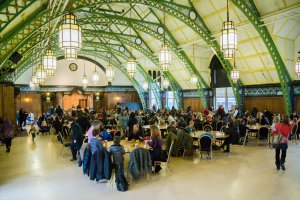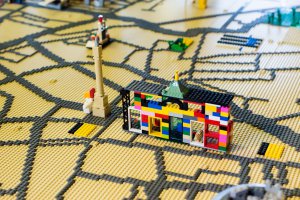Behind the scenes of the "Little Landmarks" Lego build
Bricks McGee is a talented LEGO Architect, and long-time supporter of Design Network North. He's written, and kindly shared with us, an exclusive behind the scenes of a recent LEGO build, "Little Landmarks". Read on to find out how he built not one, but ten instantly recognisable South Shields' landmarks. Make your way down to South Shields Museum & Art Gallery to see it in person!
If you are interested in how LEGO can encourage creativity - come along to our LEGO Serious Play workshop!
It’s not every day you get to play with LEGO at work, but for Bricks McGee - the AFOL (Adult Fan of LEGO) alter-ego of Richard Carter, it happens more often than you’d think. As a freelance LEGO model builder, Richard has built models of Mayfair mansions, the Laboratory of Molecular Research in Cambridge, and, more recently, 10 South Shields landmarks in LEGO.
So how do large LEGO builds like this come together?
The idea
Late in 2016, Richard was approached by the Discovery Museum in Newcastle upon Tyne, with the idea of hosting a collaborative LEGO event to appeal to families in the area. We approached the concept from many different angles, considering what a family would likely want from an event like this, and one common theme emerged - plenty of LEGO bricks to build with freely.
The idea of a large 2D map of Newcastle upon Tyne (and part of Gateshead!) was decided, with families invited to come and built their own interpretation of Newcastle - whether it was their favourite landmark, place of work, or house.

Design and production
Design was a relatively easy process, once we had decided a viable area to cover in our LEGO map. Our goal was to cover the centre of Newcastle upon Tyne so that the location of key landmarks such as St James’ Park, the Discovery Museum itself, and the famous bridges over the River Tyne would be included.
A few challenges were met in the procurement of parts. Notably, the baseplates required to provide a secure base to attach roads, rivers and landmarks to were in short supply in the UK at a reasonable cost. This was easily resolved by looking to a supplier in Poland to procure 81 LEGO baseplates in “brick yellow” (tan, to you and me). The LEGO marketplace, Bricklink.com, was vital in providing a network of sellers to provide the parts that were needed - as well as reviews of previous buyers’ experiences with the seller.
Centred on Grey’s Monument, the map was arranged on a 9-by-9 grid which covered the area from Exhibition Park in the north west of the city to the Baltic and Millennium Bridge on Gateshead quayside to the south west. From there, it was relatively simple to identify where key roads and landmarks were located.
Once the parts were gathered, the map came together rapidly, with major roads built first, and interconnecting streets and winding alleys added secondly. Artistic license allowed a little freedom to remove streets we thought people may not be familiar with, to allow greater display space for the public’s models.
The final result
The final map was delivered in 81 separate plates which were labelled with their respective coordinates; set up took just 15 minutes thanks to this!

Members of the public came to play next in sessions throughout the day, with 50,000 LEGO elements at their disposal to build whatever they desired as their contribution to the map.
The level of creativity and thought in the models was brilliant to see: the map came alive with many variations of NUFC’s homeground, St James’ Park, the Tyne Bridge, the High Level Bridge, the ornate gate to Chinatown, Newcastle’s very own space port, and even a sea monster prowling the depths of the Tyne!
Images: Tyne & Wear Archives & Museums
Design Network North is part of RTC’s new programme called ‘Designing Better Business’ – launched in 2016 - which will provide support for north east businesses looking to continue to innovate and design better world leading products.
RTC was founded in 1989 with the sole purpose of helping businesses innovate and create new higher value products. Today, the business operates out of offices in Sunderland, Gateshead, Leeds and Daresbury and specialises in helping companies develop new products, embed new skills through training and access funding for innovation.
‘Designing Better Business’ is part funded by European Regional Development Fund, as part of the European Structural and Investment Funds Growth Programme 2014-2020.